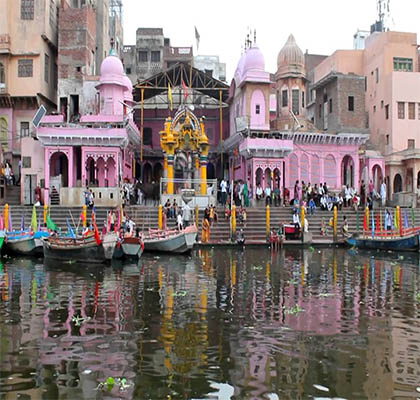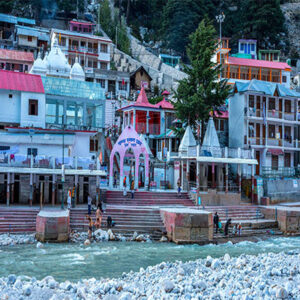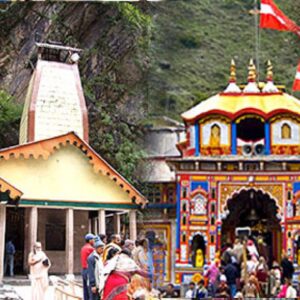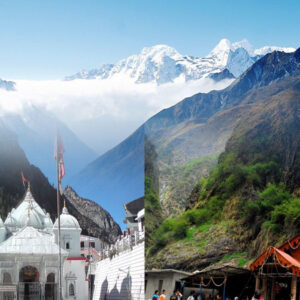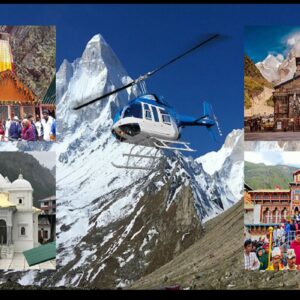Description
Chardham Yatra package assist people to plan for taking glimpse of all four religious dhams. This yatra is considered important in all Hindus life. People try to complete it once in their life. The artistic beauty of Chardhams and their elegant surroundings of beguiling Himalayan range allure people to visit here again and again. Chardham Yatra is a rostrum which provides comprehensive information of Chardham package to plan and have a safe and secure Chardham Yatra.
Chardham Yatra package has been designed to give people a solace and comfortable feeling while having an intensive experience of Chardham. This package includes visiting Kedarnath, Badrinath, Gangotri and Yamunotri. Chardham Yatra 2024 website will ensure a memorable journey. Chardham Yatra package includes not only all these four dhams but also the surroundings and touching premises of all these four dhams such as – Haridwar, Rishikesh and other places as the complete land of Uttarakhand state is full of spirituality and purity.
Itinerary
Day 01: Delhi – Haridwar
Arrive at Delhi Airport/Railway Station and Drive to Haridwar. Check into the hotel reach in Haridwar. Evening Ganga aarti at Har Ki Pauri, Mansha Devi Temple. Stay overnight at the Haridwar.
Day 02: Haridwar – Barkot(240kms/7hr)
Morning after breakfast checkout from the hotel,and drive to Barkot via Mussoorie, on the way visit Kempty Fall in Mussoorie. Later drive straight to Barkot. Check into the hotel arrival in Barkot. Stay overnight at the Barkot.
Barkot Weather– Generally agreeable in summer, the temperature ranges from 25-30 degree Celsius, Winter: The Days are pleasantly cool but the nights are cold, temp ranges from 10 deg to 05 deg.
Day 03: Barkot – Yamunotri – Barkot {36kms drive & 5 kms Trek (one side)}
Early morning after breakfast (packed breakfast), move to Jankichatti / Phoolchatti & star trek from here to Yamunotri (6kms) (Either by walk or by horse or by Doli at own cost). After taking bath in Jamunabai Kund’s warm water and having “Darshan” of “Yamunaji” back to Jankichatti by trek. Later moving towards Barkot, Stay overnight at Barkot.
Yamunotri Temple: Maharani Gularia of Jaipur constructed the temple in the 19th Century. It was destroyed twice in the present century and rebuilt again. At Yamunotri, One can cook rice by packing it in a cloth and dipping it in the hot water of the Tapt kund. Pilgrims take this cooked rice home as “Prasad”. Here near the temple “Pooja” can be offered to Divya Shila.
Surya Kund: There are a Number of thermal springs near temple, which flows into numerous pools. The most significant of these is Surya Kund.
Yamunotri Weather – In summer the maximum temp is 18 degrees and the minimum is 10 degrees Celsius. The days are pleasantly cool but the nights are cold.
Day 04: Barkot – Uttarkashi
Morning after breakfast, move to Uttarkashi. Check into the hotel reached in Uttarkashi. Visit Kashi Vishwanath Temple in Uttarkashi. Stay overnight at the Uttarkashi.
Uttarkashi is home to a number of ashrams, temples. The name of the town reflects its similarity to and location (as north of) the city of Kashi (Varanasi). Similar to Varanasi, town of Uttarkashi is also situated on the banks of River Ganga.
Vishwanath temple – Vishwanath temple is one of the oldest Shiva temples in Northern India. Re-built in 1857 by Maharani Khaneti Devi of Tehri State in the ancient architectural style. It is situated at the heart of the town. A heavy iron trident, symbolic of divine mother’s, is erected and worshiped from time immemorial at the temple complex. Ganeshji, Sakshi Gopal, Markandeya Rishi’s small shrines are also part of the temple complex. Akhand Jyoti as well as Akhand Abhishek, special aarti at morning and evening are offered. As per Skunda Puran, Uttarkashi is known as ‘Saumya Varanasi’, the abode of Lord Shiva in Kaliyug and counted as one of the twelve Jyotirlingas.
Shakti temple – Right in front of the Vishwanath temple is Shakti temple. It has a big ‘Trishul (Trident)’ of about 6 meters in height and a circumference of 90 cms. at bottom. Though there are different views about the making of this, the upper part of it seems to be made up of iron and the lower one is of copper. As per the epics this Shakti was thrown on the devils by the Goddess Durga (Shakti), hence it gets its name. Since then this Shakti is erected over here.
Uttarkashi Weather – Generally hot in summer, the temperature ranges from 30-35 degree Celsius but nights is pleasant, cold in winters.
Day 05: Uttarkashi – Gangotri – Uttarkashi
Early morning (packed breakfast) move to Gangotri, on the way at Gangotri take a sacred dip in Garam Kund, further drive to Gangotri via beautiful Harsil Valley. Harsil is famous for its nature beauty and for the majestic views of the Deodar trees and mountains. On arrival at Shree Gangotri, take a holy dip in the sacred river Ganges which is also called Bhagirathi at its origin. Perform Pooja and Darshan, after that rest for some time in the lovely surroundings. Later get back to Uttarkashi. Stay overnight at Uttarkashi.
Gangotri Temple: The temple was built by the Gorkha General Amar Singh Thapa in the 18th Century, is situated on the right bank of Bhagirathi.
Gangotri Weather – The maximum temperature during summer can go up to 20° Celsius. Summer nights can get cooler with a minimum temperature of 10° Celsius. Light woolen clothes are required while visiting Gangotri during summer. Winter season is very chilly in Gangotri. Gangotri will be covered in sheets of snow during winter. Pilgrim centres remains closed throughout winter due to massive snow falls.
Day 06: Uttarkashi – Guptkashi
Morning after breakfast, move to Guptkashi via Moolgarh & Lambgoan. On the way you can see the beautiful river Mandakini at Tilwara. The Mandakini River comes from Kedarnath, drive alongside the river to reach Guptakashi, visit Ardh Narishwar Temple in Guptakashi. Check into the hotel arrival in Guptakashi. Stay overnight at the Guptakashi.
Guptakashi:- The name Gupt Kashi means “Hidden Benares. Mythology describes how when the Pandava brothers were searching for a glimpse of Shiva, Shivji first concealed himself at Guptkashi, but later fled from them further up the valley to Kedarnath, where the Pandavas finally got their wish fulfilled. There are more tangible relations as well-the Kedarnath pandas (priests) live in Guptkashi during the winter months, and after the Kedarnath temple closes for the winter, the image of Kedarnath passes through Gupt Kashi on its way to Ukhimath (across the valley), where it stays for the winter.
Guptkashi Weather – Agreeable in summer, the temperature ranges from 25-30 degree Celsius. Cold in winters.
Day 07: Guptkashi – Kedarnath (30 kms by road & 19kms Trek one way)
Early morning after breakfast departure for Kedarnath dham. Enjoy Kedarnath Darshan. Stay overnight at Kedarnath.
By Helicopter: Morning our driver will drop you your prebook Helipad. You can inform driver about your arrival time whether it will by helicopter or by trek, so that Driver will be there to pick you up. (Note: helicopter ticket is not included in this package).
By Trek: Morning our driver will transfer you at Sonprayag then you have to take local jeep for Gaurikund & then your trek start for kedarnath ji. After darshan you follow same & return to Sonpraag. There is big parking issue so driver will back to other palace if his contact no. in not working then you have to arrange other taxi or wait for your driver.
Kedarnath: The Kedarnath shrine, one of the 12 jyotirlingas of Lord Shiva, is a scenic spot situated, against the backdrop of the majestic Kedarnath range. Kedar is another name of Lord Shiva. According to legend, the Pandavas after having won over the Kaurava in the Kurukshetra war, feel guilty of having killed their own brothers and sought the blessings of Lord Shiva for ransom. He eluded them repeatedly and while fleeing took refuge at Kedarnath in the form of a bull. On being followed he dived into the ground, leaving his hump on the surface.
Kedarnath Weather: – Due to its high elevation the weather in Kedarnath remains cold for most part of the year. Summer here is cool and agreeable while winter is severe. During summer season the temperature varies around 20°Celsius. Light woolen wear is recommended. Winter season in Kedarnath is severe with mercury falling to as low as 0°Celsius. During this time the place experiences snowfall as well. Due to the extreme chilly climatic conditions, this time is usually avoided by tourists.
Day 08: Kedarnath – Guptkashi
Day 09: Guptkashi – Badrinath
Morning after breakfast, move to Badrinath. Check in to the hotel arrival in Badrinath. Pilgrims after having a bath in the Taptkund have the Darshan of Badrivishal & Aarti in evening. Brahamakapal is important for Pinddan Shraddh of ancestors (Pitrus). There are other interesting sightseeing spot like Mana, Vyas Gufa, Maatamoorti, Charanpaduka, Bhimkund and the “Mukh” of the Saraswati River. Just within the three kms of Badrinathjee. Stay overnight at Badrinath.
Mana Village: Inhabited by an Indo-Mongolian tribe, it is the last Indian village before Tibet.
Vasundhara: As the name suggests, Vasundhara is a magnificent and beautiful water fall. This place is 5 kms. from Badrinath out of which 2 kms. is motor able up to Mana.
Bhim Pul: On the other side of Mana village, a heavy rock forming a natural bridge, lies over the roaring Saraswati river. It presents a spectacular view of water thundering down through the narrow passage under the rock and is believed to have been placed there by Bhim, the second eldest among the five Pandava brothers.
Vyas Gufa (cave): Nearly Mana Village, this is a rock-cave where Ved Vyas is believed to have appeared the Mahabharata and the pauranic commentaries.
Badrinath Weather: The maximum temperature will be around 18° Celsius and the average minimum is 8° Celsius. Warm and woolen clothes are hence required for a stay in Badrinath throughout the year. Winter in Badrinath is often accompanied by snow falls. Winter is very chilly with an average temperature of 5° Celsius. Due to the extreme chilly climatic conditions of weather, this time is usually closed for tourists.
Day 10: Badrinath – Joshimath – Srinagar
Morning after breakfast, moving for Srinagar.
Srinagar Weather – Generally hot in summer, the temperature ranges from 35-40 degree Celsius, winter: The Days are pleasantly cool but the nights are cold, temp average from 20 deg to 05 deg.
Day 11:Srinagar – Haridwar- Srinagar – Haridwar
After morning breakfast, moving for Haridwar via Rishikesh. Rishikesh ‘place of sages’ is a celebrated spiritual town on the bank of Ganga and is surrounded by Shivalik range of the Himalayas on three sides. It is said that when Raibhya Rishi did hard penances, God appeared by the name of” Hrishikesh ” and this area hence firth came to be known as Rishikesh. Check in Hotel. Later visit Rishikesh Temples & Sight Seeing – Laxman Jhulla, Ram Jhulla. Stay overnight at Haridwar.
Rishikesh: Named after the Lord Vishnu, Rishikesh is a spiritual city for Hindus. Located in the foothills of the Himalaya in northern India it is also known as the yoga centre of the world and is home to many world renowned ashrams. Rishikesh styles itself as the ‘Yoga Capital of the World’, with masses of ashrams and all kinds of yoga and meditation classes. The fast-flowing Ganges is surrounded by forested hills inside the city. Apart from temples and ashrams Rishikesh is now a popular white-water rafting centre, backpacker hang-out, and gateway to treks in the Himalaya.
Day 12:Haridwar – Mathura
Morning after breakfast checkout from the hotel and drive to Mathura, Overnight stay at mathura hotel.
Day 13: Mathura – Delhi
Morning after breakfast day excursion of Manthura & Vrindavan evening back to Delhi. Dropping at Delhi Airport/Railway station.
TOUR COST INCLUDES
- 14 Nights accommodation in above mentioned or similar hotels
- All meals at Chardham Yatra
- cab for sightseeing and excursions as per our itinerary
- Driver allowance, Toll tax and parking
TOUR COST EXCLUDES
-
- Air fare / train fare
- Camera charges.
- Coolie / porter charges.
- Donations at temples.
- Extended stay or traveling due to any reason.
- Guide & Entrance fees during sightseeing.
- Any meals other then those specified in Tour Cost Includes’
- Any other item not specified in ‘Tour cost includes’
- 5% Government service tax
TERMS & CONDITIONS
- As per the Government directive, foreigners are requested to produce their passport as photo identity proof and Indians can produce any govt. approved photo identity such as Driving License/Pan Card/Voter ID card/Passport at the point of check-in at the hotel.
- All Prices are in Indian Rupees and valid for Indian National only.
- Above mentioned rates are subject to change without prior notice.
- Rooms are subject to availability at the time of receiving firm booking.
- In case of non-availability of the mentioned hotels, similar kind/quality of hotels will be provided, which can change the above package cost.
- 100 % advance shall have to be paid before departure out of which 50% has to be paid at the time of booking tour.
- Package cost valid till 30th September
- Package rates are not applicable in festival period like Diwali & X-mas
CANCELLATION POLICY
-
- 31 days & prior to arrival – 10% of the tour/service cost.
- 30 days to 21 days prior to arrival – 15% of the tour/service cost.
- 20 days to 11 days prior to arrival – 25% of the tour/service cost.
- 10 days to 06 days prior to arrival – 50% of the tour/service cost.
- 05 days & less, prior to arrival or no show – NO REFUND
- Festivals Like Diwali, X-mas and Long weekend – No Refund on cancellation


